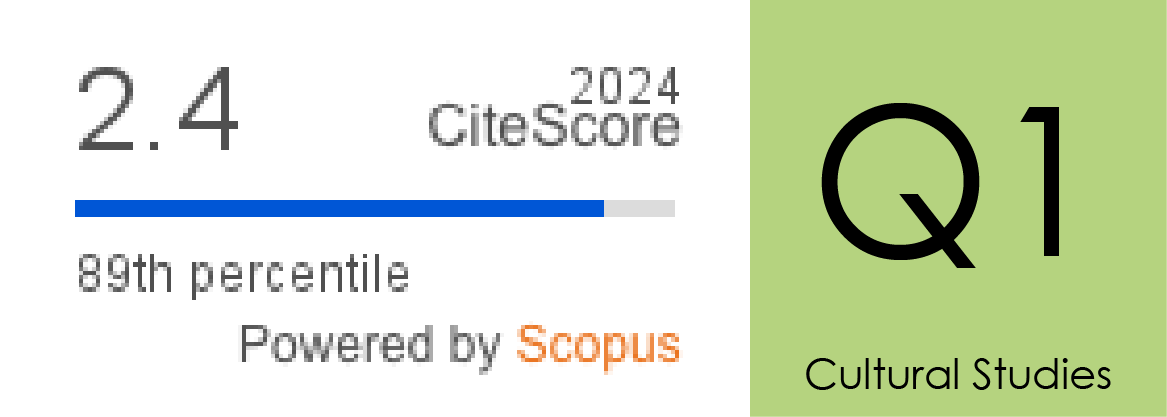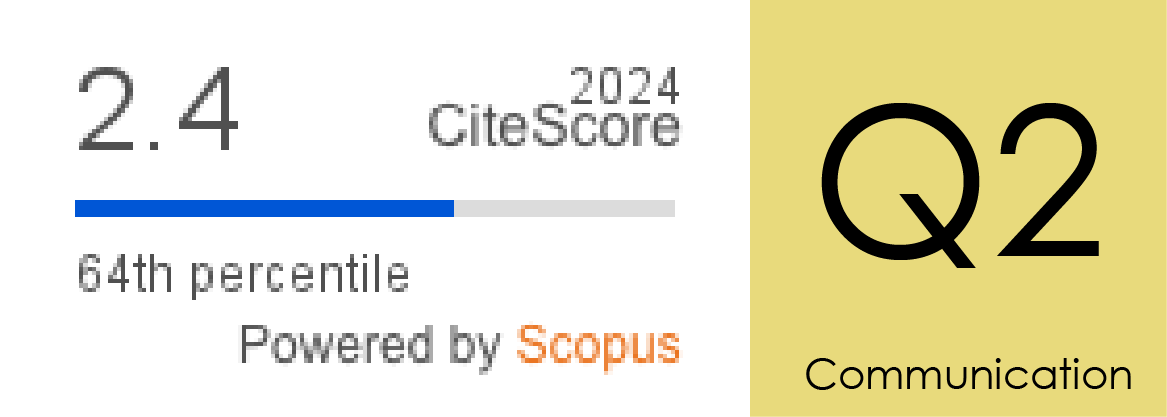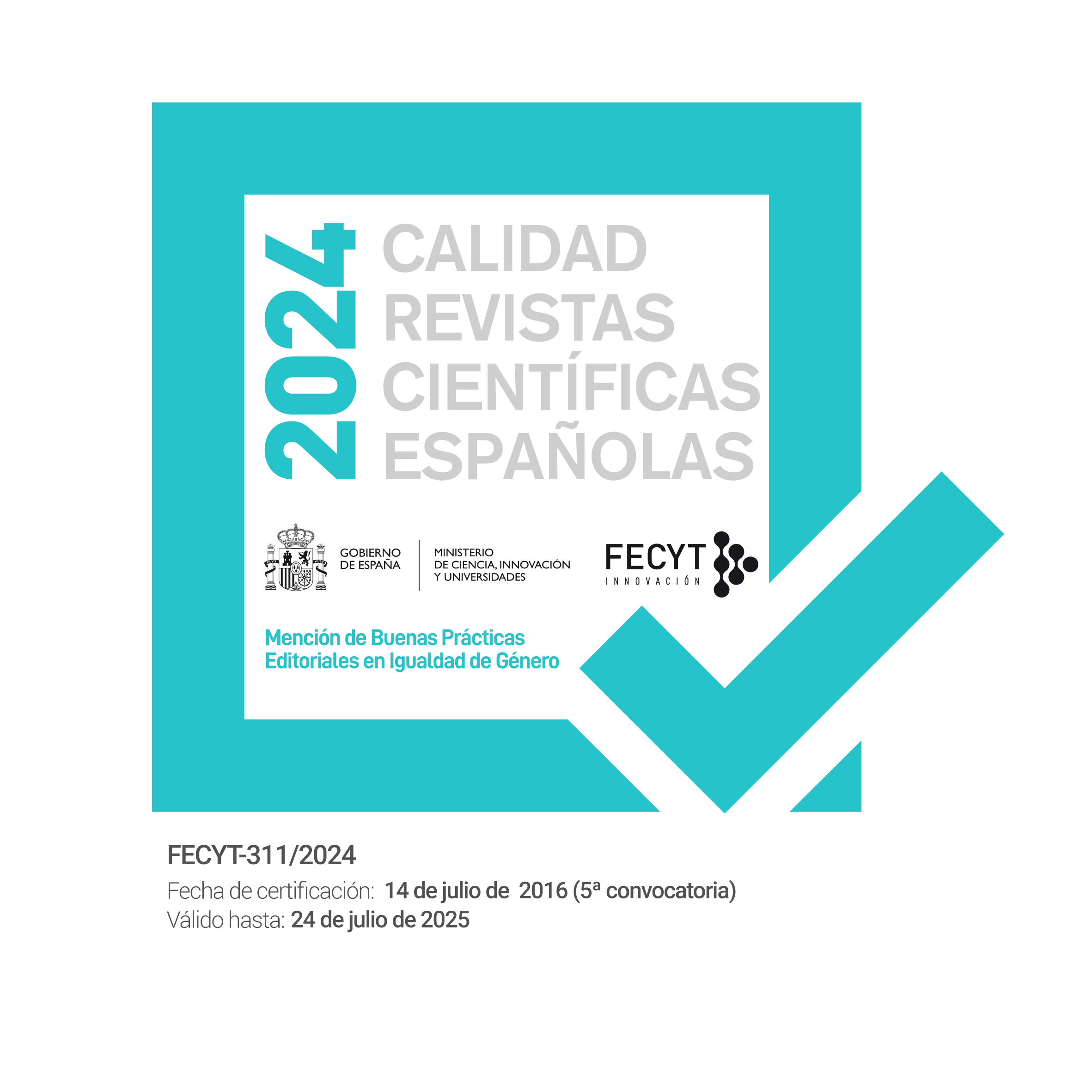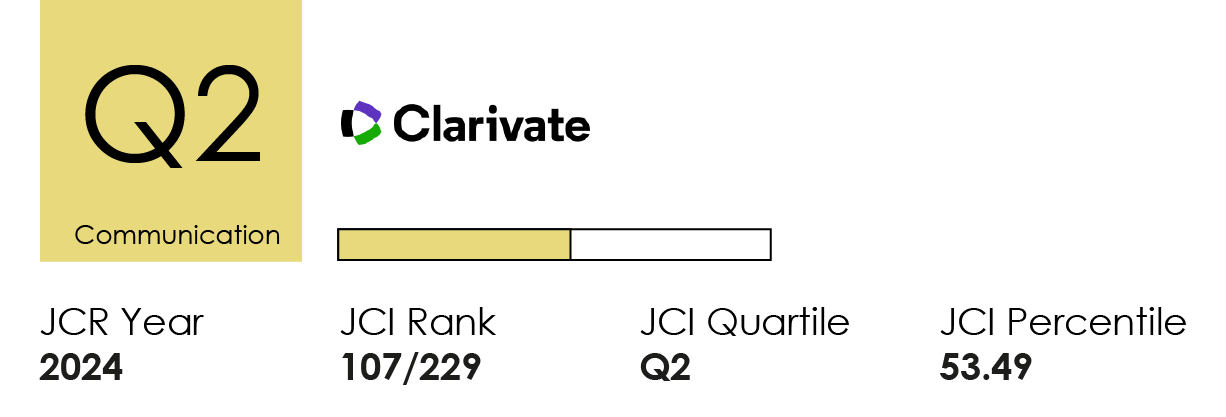Comunicación política en el entorno digital. Evaluación de las estrategias de interactividad de los think tanks europeos
DOI:
https://doi.org/10.14198/MEDCOM.26338Palabras clave:
think tanks, comunicación digital, comunicación política, interactividad, EuropaResumen
Los think tanks, como agentes sociales y políticos, han alcanzado una influencia innegable a nivel mundial en las decisiones políticas y en la formación de la opinión pública. Este estudio permite entender la comunicación digital, a través de los espacios web oficiales, de los think tanks europeos en sus relaciones en el entorno virtual. La muestra de estudio está formada por los 25 think tanks de Europa occidental más influyentes, considerando el 2020 Global Go To Think tank Index Report (McGann, 2021). Mediante un análisis de contenido, de naturaleza cuantitativa, se han examinado las herramientas comunicativas de las páginas web de dichos organismos, así como el nivel de interactividad que proporcionan. Los resultados muestran que entre las herramientas unidireccionales más utilizadas se encuentran las expositivas gráficas (folletos informativos o espacios de presentación del think tank e imágenes y fotografías) y el empleo de herramientas que posibilitan un mayor grado de interactividad. Teniendo en cuenta las bidireccionales, predominan las asimétricas, como formularios de suscripción para sindicación de contenido, sistema de búsqueda en la web, la descarga de archivos y herramientas o botones para compartir en redes sociales o enviar información a sitios externos. De forma generalizada, la investigación resalta la necesidad de los think tanks de avanzar hacia modelos bidireccionales en línea para mejorar las relaciones con los públicos.
Financiación
Ministerio de Economía y Transformación DigitalCitas
Abelson, D.E. (2006). A Capitol Idea. Think Tanks and US Foreign Policy. MGill-Queen’s University Press.
Abelson, D.E. (2009). Do think tanks matter?: Assessing the impact of public policy institutes. McGill- Queen’s University Press.
Abelson, D.E. (2012). Think tanks, Social Democracy and Social Policy. Parliamentary Affairs, 66(4), 894-902. https://doi.org/10.1093/pa/gss051
Aced, C. (2013). Relaciones Públicas 2.0. Editorial UOC.
Allern, S., & Pollack, E. (2020), The Role of Think Tanks in the Swedish Political Landscape. Scandinavian Political Studies, 43, 145-169. https://doi.org/10.1111/1467-9477.12180
Almiron, N., y Xifra, J. (2021). Repensar los think tanks. Expertos vs. impostores. Prensas de la Universidad de Zaragoza. https://bit.ly/3Izh9Kz
Arshed, N. (2017). The origins of policy ideas: The importance of think tanks in the enterprise policy process in the UK. Journal of business research, 71, 74-83. https://doi.org/10.1016/j.jbusres.2016.10.015
Avidar, R. (2013). The responsiveness pyramid: Embedding responsiveness and interactivity into public relations theory. Public Relations Review, 39(5),440-450. http://dx.doi.org/10.1016/j.pubrev.2013.05.004
Barberà, P., y Arregui, J. (2011). Naturaleza e influencia de los think tanks en el proceso político en España. Institut de Ciències Polítiques i Socials.
Bermejo Siller, C. (2016). La comunicación online en los think tanks de Europa occidental [Tesis Doctoral, Universidad de Málaga]. Repositorio Institucional. https://bitly.ws/39Lwr
Blanc, R. C. (2003). From Thatcher to the Third Way. Think-Tanks, Intellectuals and the Blair Project. Ibidem-Verlag Haunschild.
Boucher, S. (ed.) (2004). Europe and Its Think tanks: A promise to be fulfilled. Notre Europe. Studies and Research, 35. https://bit.ly/33MV6kU
Braml, J. (2006). U.S. and German Think tanks in Comparative Perspective. German Policy Studies, 3(2), 222-267. https://bit.ly/3IBDSpi
Bustos Zapata, M. P. (2021). Evaluación de usabilidad y calidad de la Información en portales web de instituciones del Trabajo en Chile, Paraguay y Uruguay [Tesis doctoral, Universidad Carlos III de Madrid]. Repositorio Institucional. https://bitly.ws/39Lwf
Capriotti, P., Carretón, C., & Castillo, A. (2016). Testing the level of interactivity of institutional websites: from museums 1.0 to museums 2.0. International Journal of Information Management (UK), 36(1), 97-104. http://dx.doi.org/10.1016/j.ijinfomgt.2015.10.003
Capriotti, P., & González-Herrero, A. (2017). From 1.0 Online Pressrooms to 2.0 Social Newsrooms at Museums Worldwide. Communication & Society, 30(2), 2017, 113-129. https://doi.org/10.15581/003.30.2.113-129
Capriotti, P., & Moreno, A. (2007). Corporate citizenship and public relations: the importance and interactivity of social responsibility issues on corporate websites. Public Relations Review, 33(1), 84-91. https://doi.org/10.1016/j.pubrev.2006.11.012
Capriotti, P., y Pardo Kuklinski, H. (2012). Assessing dialogic communication through the Internet in Spanish museums. Public Relations Review, 38(4), 619-626. https://doi.org/10.1016/j.pubrev.2012.05.005
Castelló-Sirvent, F., y Roger-Monzó, V. (2021). Los think tanks españoles durante los períodos de crisis y recuperación económica: un análisis de su concentración mediática. Revista Española de Investigaciones Sociológicas, 174, 23-46. http://dx.doi.org/10.5477/cis/reis.174.23
Castells, M. (2001). La galaxia Internet. Areté.
Castillo, A. (2009). Relaciones públicas y think tanks en América Latina. Estudio sobre su implantación y acción. Razón y Palabra, 70. 1-22. https://bit.ly/3nVIdfo
Castillo, A., y Castillero, E. (2012). Los think tanks como actores de influencia política en Europa. Análisis de su implantación en Europa del Este. Trípodos. Extra, 129-146. https://bitly.ws/39Lx7
Castillo-Esparcia, A., Almansa-Martínez, A., & Smolak-Lozano, E. (2015). East European think tanks in social media - Towards the model of evaluation of effective comunication /PR strategist: Case study analysis. Catalan journal of communication and cultural studies, 7(2), 231-250. https://doi.org/10.1386/cjcs.7.2.231_1
Castillo-Esparcia, A., Castillero-Ostio, E., y Castillo-Díaz, A. (2020). Los think tanks en España. Análisis de sus estrategias de comunicación digitales. Revista Latina de Comunicación Social, 77, 253-273. https://www.doi.org/10.4185/RLCS-2020-1457
Castillo-Esparcia, A., García-Ponce, D., y Smolak-Lozano, E. (2013). Movimientos sociales y estrategias de comunicación. El caso de 15-M y de Occupy Wall Street. Estudios Sobre El Mensaje Periodístico, 19(1), 71-89. http://dx.doi.org/10.5209/rev_ESMP.2013.v19.n1.42508
Castillo-Esparcia, A., Guerra-Heredia, S., & Almansa-Martínez, A. (2017). Political communication and think tanks in Spain. Strategies with the media. El profesional de la información, 26(4), 706-713. https://doi.org/10.3145/epi.2017.jul.14
Castillo, A., y Smolak, E. (2016). La comunicación de los think tanks. Análisis de la estrategia digital. Opción, 32(9), 327-342. https://produccioncientificaluz.org/index.php/opcion/article/view/21740/21525
Castillo, A., y Smolak, E. (2017). Relaciones públicas digitales. Análisis de las estrategias de comunicación de los think tanks. Obra Digital, 13, 59-80. https://bit.ly/3rMay8L
Chuliá, E. (2018). Una aproximación a los think tanks como organizaciones proveedoras de información y análisis a la sociedad. Revista española de sociología, 27(2), 333-340. https://doi.org/10.22325/fes/res.2018.27
Cockett, R. (1995). Thinking the Unthinkable: Think-tanks and the Economic Counter-revolution, 1931-83. Fontana Press.
Codina, L., Pedraza-Jiménez, R., Díaz-Noci, J., Rodríguez-Martínez, R., Pérez-Montoro, M., y Cavaller-Reyes, V. (2014). Sistema Articulado de Análisis de Cibermedios (SAAC): Una propuesta sobre el qué y el cómo para estudiar medios de comunicación digitales. Hipertext.net, 12. https://bitly.ws/39Lxf
Coombs, T., & Holladay, S. (2015). Public Relations ‘relationships identity’ in research: Enlightenment or Illusion. Public Relations Review, 41(5), 689-695. https://doi.org/10.1016/j.pubrev.2013.12.008
Dahl, R. A. (1989). Democracy and its critics. Yale University Press.
Denham, A. (2005). British think-tanks and the climate of opinion. Routledge.
Denham, A., & Garnett, M. (1998). British Think Tanks and the Climate of Opinion. UCL Press.
Devaux, S. (2006). Old networks, new roles? The role of environmental think tanks in the Czech Republic. Perspectives on European Politics and Society, 7(2), 221-235. https://doi.org/10.1080/15705850600840072
Domhoff, G. W. (1990). The Power Elite and the State: How Policy Is Made in America. Aldine de Gruyter.
Domhoff, G. W. (2010). Who Rules America? (6ª ed.). McGraw Hill.
Duhé, S. (2015). An Overview of New Media Research in Public Relations Journals from 1981 to 2014.
Public Relations Review, 41(2), 153-169. https://doi.org/10.1016/j.pubrev.2014.11.002
Fernández-Cavia, J., Rovira, C., Díaz-Luque, P., & Cavaller, V. (2014). Web Quality Index (WQI) for official tourist destination websites. Tourism Management Perspectives, 9, 5-13. https://doi.org/10.1016/j.tmp.2013.10.003
Fischer, K., & Plehwe, D. (2017) Neoliberal Think tank Networks in Latin America and Europe: Strategic Replication and Cross-National Organizing. In A. Salas-Porras y G. Murray (eds.), Think Tanks and Global Politics (pp.159-186). Palgrave Macmillan. https://doi.org/10.1057/978-1-137-56756-7_7
Freres, C., Seabra, M., & Moraes, M. R. (2000). Think tanks in Spain and Portugal: Searching for relevance. En J.G. McGann y R.K. Weaver. (eds.), Think Tanks and Civil Societies: Catalysts for Ideas and Actions. Transaction Publishers.
Gershon, R. (2016). Digital Media and Innovation. Management and Design. Strategies in Communication. Sage.
González-Capitel, J., y Ponsa, F. (2015). Radiografía de los think tanks en España. Informe Funciva. https://bit.ly/3Hc1sbO
González-Capitel, J., Ponsa, F., Guasp, M., Quintana, F., y López, M. (2017). La financiación de las ideas. Índice de transparencia financiera de los think tanks españoles (2016). Observatorio de los think tanks.
Guerra Heredia, S. (2014). La comunicación de los think tanks en España. Panorama y estrategias comunicativas [Tesis doctoral, Universidad de Málaga]. Repositorio Institucional. https://bitly.ws/39Lxi
Guillory, J. E., & Sundar, S. S. (2014). How does website interactivity affect our perceptions of an organization? Journal of Public Relations Research, 26(1), 44–61. https://doi.org/10.1080/1062726X.2013.795866
Gustavsen, P., & Tilley, E. (2003). Public relations communication through corporate websites: Towards an understanding of the role of interactivity. Prism, 1(1). http://www.prismjournal.org
Hassenzahl, M., & Tractinsky, N. (2006). User experience-a research agenda. Behaviour& information technology, 25(2), 91-97. https://doi.org/10.1080/01449290500330331
Haughton, G., & Allmendinger, P. (2016). Think tanks and the pressures for planning reform in England. Environment and Planning C: Politics and Space, 34(8), 1676-1692. https://doi.org/10.1177/0263774X16629677
Heinze, N., & Hu, Q. (2006). The evolution of corporate web presence: a longitudinal study of large American companies. International Journal of Information Management, 26(4), 313-325. https://doi.org/10.1016/j.ijinfomgt.2006.03.008
Holtz, S. (2002). Public relations on the Net: winning strategies to inform and influence the media, the investment community, the government, the public, and more. Amacom.
Ingenhoff, D., & Koelling, A. M. (2009). The potential of websites as a relationship building tool for charitable fundraising NPOs. Public Relations Review, 35(1),66-73. https://doi.org/10.1016/j.pubrev.2008.09.023
Jo, S., & Jung, J. (2005). A cross-cultural study of the world wide web and public relations. Corporate Communications: An International Journal, 10(1), 24-40. https://doi.org/10.1108/13563280510578187
Jo, S., & Kim, Y. (2003). The effect of Web characteristics on relationship building. Journal of Public Relations Research, 15(3), 199–223. https://doi.org/10.1207/S1532754XJPRR1503_1
Kent, M.L. (2013). Using social media dialogically: public relations role in reviving democracy. Public Relations Review, 39(4), 337-345. https://doi.org/10.1016/j.pubrev.2013.07.024
Kent, M. L., & Lane, A. (2021). Two-way communication, symmetry, negative spaces, and dialogue. Public Relations Review, 47(2), 1-9. https://doi.org/10.1016/j.pubrev.2021.102014
Kent, M.L., & Taylor, M. (1998). Building dialogic relationships through the worldwide web. Public Relations Review, 24(3), 321-334. https://doi.org/10.1016/S0363-8111(99)80143-X
Kent, M.L., & Taylor, M. (2002). Toward a dialogic theory of public relations. Public Relations Review, 28(1), 21-37. https://bit.ly/343yWdW
Kent, M.L., & Taylor, M. (2021). Fostering Dialogic Engagement: Toward an Architecture of Social Media for Social Change. Social Media+Society, 7(1), 1-10. https://doi.org/10.1177/2056305120984462
Kim, S., Park, H., & Wertz, E. K. (2010). Expectation gaps between stakeholders and web-based corporate public relations efforts: focusing on Fortune 500 corporate websites. Public Relations Review, 36(3), 215-221. https://doi.org/10.1016/j.pubrev.2010.04.001
Kingdon, J. (1984). Agendas, alternatives and public policies. Brown.
Kiousis, S. (2002). Interactivity: a concept explication. New Media and Society, 4(3), 355-383. https://doi.org/10.1177/146144480200400303
Klüver, H. (2011). The contextual nature of lobbying: Explaining lobbying success in the European Union. European Union Politics, 12(4), 483-506. https://doi.org/10.1177/1465116511413163
Lalueza, F., & Girona, R. (2016). The Impact of Think tanks on Mass Media Discourse Regarding the Economic Crisis in Spain. Public Relations Review, 42(4), 271-278. https://doi.org/10.1016/j.pubrev.2015.09.006
La Porte, T. (2019). Las reglas del “nuevo poder de influencia”: Un análisis de las estrategias de think tanks globales desde una perspectiva comunicativa. Austral Comunicación, 8(1), 9-36. https://doi.org/10.26422/aucom.2019.0801.lap
Landry, J. (2021). Critical Perspectives on Think Tanks: Power, Politics and Knowledge. Edward Elgar Publishing.
Leiner, D., & Quiring, O. (2008). What interactivity means to the user: essential insights into and a scale for perceived interactivity. Journal of computer-mediated communication, 14(1), 127-155. https://doi.org/10.1111/j.1083-6101.2008.01434.x
Lenglet, R., & Vilain, O. (2011). Un pouvoir sous influence - Quand les think tanks confisquent la démocratie. Armand Colin.
Li, Ch. (2017). The Power of Ideas: The Rising Influence of Thinkers and Think Tanks in China. WSPC.
Liberos, E. (coord.) (2013). El libro de Marketing Interactivo y la Publicidad Digital. ESIC Editorial.
López-Rabadán, P., & Mellado, C. (2019). Twitter as a space for interaction in political journalism. Dynamics, consequences and proposal of interactivity scale for social media. Communication & Society, 32(1), 1-18. https://doi.org/10.15581/003.32.37810
Lowery, D. (2007). Why Do Organized Interest Lobby? A Multi-goal, Multi-Context Theory of Lobbying. Polity, 39(1), 29-54. https://doi.org/10.1057/palgrave.polity.2300077
Martínez-Oña López, Mª E. (2016). La comunicación de los think tanks económicos en España [Tesis doctoral, Universidad de Málaga]. Repositorio Institucional. https://bitly.ws/39Lxk
McAllister-Spooner, S. (2009). Fulfilling the dialogic promise: a ten-year reflective survey on dialogic Internet principles. Public Relations Review, 35(3), 320–322. https://doi.org/10.1016/j.pubrev.2009.03.008
McGann, J.G. (2021a). The Future of Think Tanks and Policy Advice Around the World. Palgrave Macmillan.
McGann, J.G. (2021b). 2020 Global Go To Think Tank Index Report. TTCSP Global Go To Think Tank Index Reports. https://bitly.ws/39Lxq
McGann, J.G., & Johnson, E. (2005). Comparative Think Tanks, Politics and Public Policy. Edward Elgar.
McGann, J.G., & Weaver, R. K. (eds.) (2000). Think Tanks and Civil Societies: Catalysts for Ideas and Actions. Transaction Publishers.
McGann, J.G., & Weaver, K. (eds.) (2009). Think tanks and civil societies: Catalysts for action. Transaction Publishers.
McLevey, J. (2013). Producing and Promoting Policy Ideas: A Study of Think Tanks in Canada [Tesis doctoral, McMaster University]. Repositorio Institucional. https://bitly.ws/39Lxu
Medvetz, T. (2008). Think Tanks as an Emergent Field. The Social Science Research Council. http://bit.ly/1qCXTTR.
Medvetz, T. (2012). Think Tanks in America. University of Chicago Press.
Mendizábal, E. (2014). What is a think tank? Defining the boundaries of the label. On Think Tanks. On Think tanks. Independent Research, Ideas and Advice. http://bit.ly/2ojBslE
Michaels, J.H. (2014). The Heyday of Britain’s Cold War Think tank: Brian Crozier and the Institute for the Study of Conflict, 1970–79. In L. van Dongen, S. Roulin y G. Scott-Smith (eds.), Transnational Anti-Communism and the Cold War. The Palgrave Macmillan Transnational History Series (pp. 146-160). Palgrave Macmillan. https://doi.org/10.1057/9781137388803_10
Montobbio, M. (2013). La geopolítica del pensamiento. Think tanks y política exterior. CIDOB y Real Instituto Elcano.
Morales, J.C. (2017). Los centros de pensamiento y su influencia en la política exterior y de seguridad [Tesis doctoral, UNED]. Repositorio Institucional. https://bit.ly/3fV4YLP
Motion, J. (2001). Electronic relationships: Interactivity, Internet branding and the public sphere. Journal of Communication Management, 5(3), 217-230. https://doi.org/10.1108/13632540110806785
Oliveira, A., & Capriotti, P. (2014). Internet as a key tool for publics to communicate with organizations. The case of the Spanish energy sector. Catalan Journal of Communication & Cultural Studies, 6(1), 143-151. https://bit.ly/3IrolIK
Oreskes, N., & Conway, E. M. (2010). Merchants of Doubt. How a Handful of Scientists Obscured the Truth on Issues from Tobacco Smoke to Global Warming. Bloomsbury.
Park, H., & Reber, B. H. (2008). Relationship building and the use of websites: how Fortune 500 corporations use their Websites to build relationships. Public Relations Review, 34(4), 409-411. https://doi.org/10.1016/j.pubrev.2008.06.006
Parrilla, R., Almiron, N., & Xifra, J. (2016). Crisis and Interest: The Political Economy of Think tanks During the Great Recession. American Behavioral Scientist, 60(3), 340-359. https://doi.org/10.1177/0002764215613404
Pautz, H. (2007). Scottish Think-Tanks and Policy Networks. Scottish Affairs 58(1), 57-77. https://doi.org/10.3366/scot.2007.0004
Pautz, H. (2008), Think-tanks in Germany: the Bertelsmann Foundation’s role in labour market reform. Zeitschrift für Politikberatung, 1, 437-456. https://doi.org/10.1007/s12392-008-0044-8
Pautz, H. (2010). Think tanks in the United Kingdom and Germany: Actors in the Modernisation of Social Democracy. The British Journal of Politics and International Relations, 12(2), 274-294. https://doi.org/10.1111/j.1467-856X.2010.00402.x
Pautz, H. (2011). Revisiting the think-tank phenomenon. Public Policy and Administration, 26(4), 419-435. https://doi.org/10.1177/0952076710378328
Pautz, H. (2013). The Think tanks behind ‘Cameronism’. The British Journal of Politics and International Relations, 15, 362-377. https://doi.org/10.1111/j.1467-856X.2012.00518.x
Pautz, H. (2014). British think-tanks and their collaborative and communicative networks. Politics, 34(4), 345-361. https://doi.org/10.1111/1467-9256.12056
Pautz, H. (2017). Managing the crisis? Think-tanks and the British response to Global Financial Crisis and Great Recession. Critical Policy Studies, 11(2), 191-210. https://doi.org/10.1080/19460171.2016.1166974
Paz Espinoza, F.A. (2017). Método para la evaluación de usabilidad de sitios web transaccionales basado en el proceso de inspección heurística [Tesis doctoral, Pontificia Universidad Católica del Perú - CENTRUM Católica]. Repositorio Institucional. https://bit.ly/3FYxsPs
Pescheck, J. G. (1987). Policy Planning Organizations: Elite Agendas and America’s Rightward Turn. PA. Temple UniversityPress.
Pineda, A., Hernández-Santaolalla, V., Algaba, C., & Barragán-Romero, A. (2019). The politics of think tanks in social media: FAES, YouTube and free-market ideology. International Journal of Media & Cultural Politics, 15(1), 3-25. https://doi.org/10.1386/macp.15.1.3_1
Planells, E. (2017). Análisis de la representación e impacto de los think tanks españoles en la prensa online (2012-2016) [Tesis doctoral, Universidad de Valencia]. Repositorio Institucional. https://bitly.ws/39LxH
Planells-Artigot, E., Martí-Sánchez, M., & Moreno-Castro, C. (2020). Presence of think tanks in the Spanish digital press. Profesional De La Información, 29(5). https://doi.org/10.3145/epi.2020.sep.17
Ponsa, F. (2014). Evolució històrica i models de Think Tanks a Catalunya. El cas de les fundacions dels partitspolítics [Tesis doctoral, Universitat Pompeu Fabra]. Repositorio Institucional. https://bit.ly/3KE9xs5
Ponsa, F. (2016). Anàlisi de la influència del think tanks interns dels partits polítics catalans a través de la presència mediàtica. Comunicació: Revista de Recerca i d’Anàlisi, 33(1), 27-51, doi:10.2436/20.3008.01.141.
Ponsa, F., y Xifra, J. (2012). Guia de think tanks a Catalunya. Sehen.
Quintana Pujalte, L., y Castillo Esparcia, A. (2019). Relaciones públicas avanzadas: estudio del nivel de interactividad de los Think Tanks destacados en el uso de redes. International Journal of Latest Research in Humanities and Social Science (IJLRHSS), 2(8), 44-54. https://bitly.ws/39LxK
Ramírez-Torres, P. X., Paredes-Amaguaya, A. I., Bejarano-Gavilanes, X. P., y Pomaquero-Yuquilema, M. L. (2020). Análisis de tendencias de diseño gráfico aplicadas en diseño web. Dominio de las Ciencias, 6(2), 923-932. http://dx.doi.org/10.23857/dc.v6i3.1257
Requejo, F. (1999). Els think tanks a Catalunya. Universitat Pompeu Fabra.
Roger-Monzó, V., y Castelló-Sirvent, F. (2020). Think tanks españoles: análisis longitudinal de su presencia en medios nacionales e internacionales (2004-2018). El Profesional de la Información, 29(3), e290331. https://doi.org/10.3145/epi.2020.may.31
Rovira, C., y Marcos, M.C. (2013). Diseño de sitios web: disciplinas, materias y esquemas integradores. Hipertext.net, 11. https://bit.ly/3IzdFaX
Ruser, A. (2019). Climate Politics and the Impact of Think Tanks: Scientific Expertise in Germany and the US. Palgrave MacMillan.
Saffer, A. J., Sommerfeldt, E.J., & Taylor, M. (2013). The effects of organizational Twitter interactivity on organization-public relationships. Public Relations Review, 39(3), 213-215. https://doi.org/10.1016/j.pubrev.2013.02.005
Saloma, J. (1984). Ominous Politics: The New Conservative Labyrinth. Hill and Wang.
Sánchez, J. A., y Pizarro, J. (2014). Ideas locales que viajan en inglés: análisis de redes de think-tanks en Twitter. Real Instituto Elcano. https://bit.ly/348fPzy
Santillán, J. R. (2012). Think tanks y sus estrategias comunicativas. Redmarka, 8, 201-222. https://doi.org/10.17979/redma.2012.01.08.4749
Shaw, S., Rusell, J., Greenhalgh, T., & Korica, M. (2014). Thinking about think tanks in health care: a call for new research agenda. Sociology of Health & Illness, 36(3), 447-461. https://doi.org/10.1111/1467-9566.12071
Sherrington, P. (2000a). Shaping the policy agenda: Think tank activity in the European Union. Global Society, 14(2), 173-189. https://doi.org/10.1080/13600820050008430
Sherrington, P. (2000b). British think tanks: Advancing the intellectual debate? The British journal of politics & international relations, 2(2), 256-263. https://doi.org/10.1111/1467-856X.00036
Simon, J. (1993). The idea brokers: the impact of think tanks on British government. Public administration, 71(4), 491-506. https://doi.org/10.1111/j.1467-9299.1993.tb00988.x
Smolak, E. (2017). Relaciones públicas 2.0 y Think Tanks. Análisis de Social Media como estrategia de comunicación [Tesis doctoral, Universidad de Málaga]. Repositorio Institucional. https://bitly.ws/39LxP
Soto, M.J. (2020). La interacción del usuario con el diseño web en función de su composición cromática. MADGU. Mundo, Arquitectura, Diseño gráfico y Urbanismo, 3(5), 17. https://doi.org/10.36800/madgu.v3i5.49
Stefancic, J., & Delgado, R. (1996). No Mercy: How Conservative Think Tanks and Foundations Changed. Temple University Press.
Stone, D. (2007). Recycling Bins, Garbage Cans or Think tanks? Three Myths Regarding Policy Analysis Institutes. Public Administration, 85(2), 259-278. http://bit.ly/1xjA2Wa
Stone, D., & Denham, A. (2004). Think Tank Traditions: Policy Research and the Politics of Ideas. Manchester University Press.
Stone, D., Denham A., & Garnett, M. (eds.) (1998). Think Tanks across Nations: A comparative Approach. Manchester University Press.
Stromer-Galley, J. (2004). Interactivity-as-product and interactivity-as-process. The Information Society, 20(5), 391-394. https://doi.org/10.1080/01972240490508081
Taylor, M., & Kent, M. (2014). Dialogic engagement: clarifying foundational concepts. Journal of Public Relations Research, 26(5), 384–398. https://doi.org/10.1080/1062726X.2014.956106
Tello-Beneitez, M. (2013). Guía de think tanks en España. Centro Francisco Tomás y Valiente. UNED Alzira-Valencia. https://bit.ly/3fWBnla
Truman, D. B. (1951). The Governmental Process; political interests and public opinion. Knopf.
Urrutia, O. (2013). El papel de los think tanks en la definición y aplicación de las políticas y estrategias de defensa. Revista del Instituto Español de Estudios Estratégicos, 2(7), 189-222. https://bitly.ws/39LxQ
Urrutia, O. (2017). Foreign policies in Spain: The role of think tanks in the battle between Central State and Catalonia? In D. Abelson, S. Brooks y X. Hua (eds.), Think tanks, Foreign Policy and Geo-Politics. Routledge. https://bit.ly/3nXkxab
Van Ruler, B. (2015). Agile Public Relations Planning: The Reflective Communication Scrum. Public Relations Review, 41(2), 187-194. https://doi.org/10.1016/j.pubrev.2014.11.008
Villumsen, T. (2007). Think tanks in Europe: Shaping ideas of security. Militært Tidsskrift, 136(2), 143-161.https://bit.ly/3FSsILe
Weaver, R. K. (1989). The changing world of think tanks. PS: Political Science and Politics, 22(3), 563-578.
Xifra, J. (2005). Los think tanks y advocacy tanks como actores de la comunicación política. Anàlisi, 32, 73-91. https://bitly.ws/39LxX
Xifra, J. (2008). Los think tanks. Editorial UOC.
Descargas
Estadísticas
Publicado
Cómo citar
Número
Sección
Licencia
Derechos de autor 2018 Elizabet Castillero-Ostio, Andrea Moreno-Cabanillas, Álvaro Serna-Ortega

Esta obra está bajo una licencia internacional Creative Commons Atribución 4.0.
Los autores y autoras que publican en esta revista están de acuerdo con los siguientes términos:
1 Derechos de autor. Los autores y autoras conservan sus derechos de autor, aunque ceden a la revista de forma no exclusiva los derechos de explotación (reproducción, distribución, comunicación pública y transformación) y garantizan a esta el derecho de primera publicación de su trabajo, el cual estará simultáneamente sujeto a la licencia indicada en punto 2. Los autores pueden establecer otros acuerdos adicionales para la distribución no exclusiva de la versión de la obra publicada en la revista, siempre que exista un reconocimiento de su publicación inicial en esta revista.
© Los autores.
2 Licencia. Los trabajos se publican en la revista sujetos a la licencia de Reconocimiento 4.0 Internacional de Creative Commons (CC BY 4.0); los términos se pueden consultar en https://creativecommons.org/licenses/by/4.0/
Esta licencia permite a terceros compartir (copiar y redistribuir el material en cualquier medio o formato) y adaptar (remezclar, transformar y crear a partir del material para cualquier finalidad, incluso comercial), siempre que se reconozca la autoría y la primera publicación en esta revista (Revista Mediterránea de Comunicación (RMC) / Mediterranean Journal of Communication (MJC), Universidad de Alicante, DOI de la obra), se proporcione un enlace a la licencia y se indique si se han realizado cambios en la obra.
3 Política de autoarchivo. Se recomienda a los autores que difundan sus trabajos a través de Internet para favorecer una circulación y difusión más rápidas y, con ello, un posible aumento en la citación y alcance entre la comunidad científica y académica, en las siguientes condiciones:
No se permite a los autores depositar en un repositorio institucional o temático, página web propia, etc., las versiones preprint (versión antes de ser evaluada) o postprint (versión evaluada y aceptada para su publicación) de sus trabajos antes de su publicación, pero sí el artículo final publicado (versión del editor).













